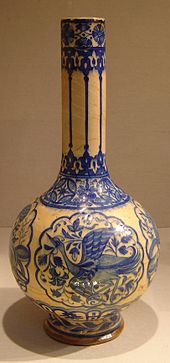
Back تزجيج الخزف Arabic Паліва (кераміка) Byelorussian Паліва (кераміка) BE-X-OLD Ceràmica vidrada Catalan Glazura Czech Keramisk glasur Danish Glasur (Keramik) German Glazuro Esperanto Cerámica vidriada Spanish Glasuur Estonian


Ceramic glaze, or simply glaze, is a glassy coating on ceramics. It is used for decoration, to ensure the item is impermeable to liquids and to minimise the adherence of pollutants.[1]
Glazing renders earthenware impermeable to water, sealing the inherent porosity of earthenware. It also gives a tougher surface. Glaze is also used on stoneware and porcelain. In addition to their functionality, glazes can form a variety of surface finishes, including degrees of glossy or matte finish and color. Glazes may also enhance the underlying design or texture either unmodified or inscribed, carved or painted.
Most pottery produced in recent centuries has been glazed, other than pieces in bisque porcelain, terracotta, and some other types. Tiles are often glazed on the surface face, and modern architectural terracotta is often glazed. Glazed brick is also common. Sanitaryware is invariably glazed, as are many ceramics used in industry, for example ceramic insulators for overhead power lines.
The most important groups of traditional glazes, each named after its main ceramic fluxing agent, are:
- Ash glaze, traditionally important in East Asia, simply made from wood or plant ash, which contains potash and lime.
- Feldspathic glazes of porcelain.
- Lead glazes, plain or coloured, are glossy and transparent after firing, which need only about 800 °C (1,470 °F). They have been used for about 2,000 years in China e.g. sancai, around the Mediterranean, and in Europe e.g. Victorian majolica.
- Salt-glaze, mostly European stoneware. It uses ordinary salt.
- Tin-glaze, which coats the ware with lead glaze made opaque white by the addition of tin.[2] Known in the Ancient Near East and then important in Islamic pottery, from which it passed to Europe. Includes Hispano-Moresque ware, Italian Renaissance maiolica (also called majolica), faience and Delftware.
Glaze may be applied by spraying, dipping, trailing or brushing on an aqueous suspension of the unfired glaze. The colour of a glaze after it has been fired may be significantly different from before firing. To prevent glazed wares sticking to kiln furniture during firing, either a small part of the object being fired (for example, the foot) is left unglazed or, alternatively, special refractory "spurs" are used as supports. These are removed and discarded after the firing.
- ^ Division, Company Statistics. "Statistics of U.S. Businesses Main Page". www.census.gov. Archived from the original on 26 November 2015. Retrieved 27 November 2015.
- ^ C D Fortnum, 1875, Maiolica, Chapter II on Enamelled or Stanniferous Glazed Wares "It was found that by the addition of a certain portion of the oxide of tin to the composition of glass and oxide of lead the character of the glaze entirely alters. Instead of being translucent it becomes, on fusion, an opaque and beautifully white enamel…"